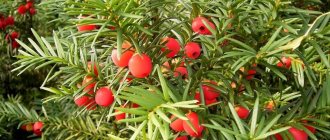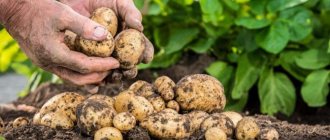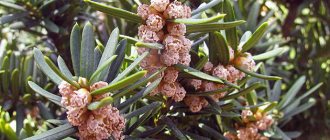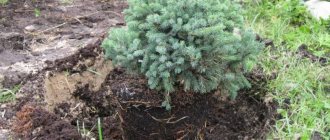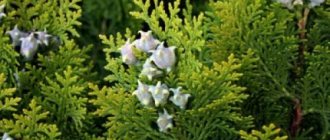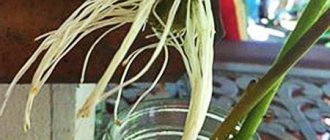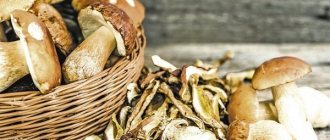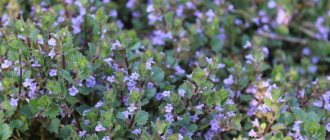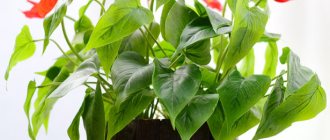Yew (lat. Taxus) is a garden ornamental crop of the Yew family. It can be a tree or a shrub, depending on whether it belongs to one of eight species. Several varieties of conifers, also called yews, are found in Europe and Asia, one in North Africa. The most frost-resistant ones grow in the Far East and Norway. Gradually, wild species of yew are disappearing, and cultivation by gardeners is increasing, since it requires minimal care and fits well into the landscape.
Description of the yew tree
Yew has dense branches with dark green soft needles, forming a round or cylindrical crown consisting of several peaks. Shrub species grow no more than 10 m in height, and trees 20 m or more. The red-brown tree trunk, about 4 m thick, is covered with small scales. On female plants, scarlet berries 5-8 mm in diameter ripen, beautifully diluting the thick greenery, which makes male bushes with single round cones less popular.
Any part of the perennial contains toxic substances that are widely used for medical purposes, which is why yew is protected by government agencies for environmental protection.
Slow-growing yew has strong and pest-resistant wood. Thanks to its density and resistance to rot, the tree is unpretentious to its growing areas and long absence of sun. Previously, furniture was made from yew and log houses were built for houses.
Types and varieties of yew
| View | Crown | Features / Variety | Height, m |
| Berry | Cylindrical, ovoid, sometimes multivertex. | It is found in the forests of mountainous Caucasian, Asian and European areas. Dense needles, double-rowed on the lateral branches and spiral on the upper branches. Deep green in color, glossy on the front and velvety yellow on the back. The red trunk of the tree is layered, uneven, with grayish spots.
| 1,7-2,7 |
| Canadian | Pyramidal. | A frost-resistant, recumbent shrub that grows in the northern regions of America. The branches growing upward are covered with thick pale curved needles.
| 1-2 |
| Pointed | Oval, wide, loose. | Grows in the Far East and Japan. The sickle-shaped sparse needles are dark and pale green underneath. The stems, yellow at the top, turn brown downwards. The tree's berries are pink in color. Shrub species up to 1.5 m.
| 0,7-2 |
| Shortleaf | Wide, pin-shaped. | A species of tree from North America with drooping branches growing perpendicular to the trunk. Double-row yellowish needles 20 mm long. The fruits are bright red. Shrub form up to 5 m high. | 1,5-2,5 |
| Average | Round, lush. | The needles are two-row, 28 mm long, with a clear median vein. The ascending branches are olive, reddish at the ends. Frost-resistant.
| 5 |
Yew berry
Yew berry - (lat. Taxus baccata), you can find the spelling Yew. It is part of the Yew family and belongs to the coniferous species.
origin of name
There are quite a few theories about the origin of the names “Yew” - from the Russian “tslav”, which means “cedar, pine”, to Serbian, Bulgarian, Polish roots, meaning varieties of coniferous trees. Most likely, the Greek origin would be more plausible, meaning “bow” in the singular (as a weapon) and “arrows” in the plural, which is associated with the production of bows and arrows from the strong wood of the shrubby forms of this plant. There are also such comparative names of the plant as zelenitsa, negnyuchka, negnoy, mahogany - this is due to the peculiarities of the appearance and characteristics of the plant, which is slightly susceptible to rotting and decomposition, has a specific dark emerald color of needles and the color of the wood as in freshly cut form, and after processing.
Description
The yew grows up to 10-20 m, but there are unique specimens reaching 26-29 m. This tree is a long-liver, with very slow growth it can live from 1.5 to 4 thousand years, growing in diameter up to 1.5-2.8 m. During the growth process, a beautiful and very dense ovoid crown of a rich green hue is formed, which often consists of several peaks. The trunk of the Yew is protected by a smooth and lamellar bark, which has a reddish with a gray tint, and it is covered with multiple dormant buds, which, under favorable conditions, produce lateral shoots, which forms the unusual crown of the Yew. The needles (leaves) are not the usual faceted shape, like those of conifers, but are flat and elongated, 2-3.5 cm in length, 2 mm wide, glossy, the upper and lower sides are different in color. Yew can be either dioecious or monoecious. It has two types of cones - anther and seed. Flowering begins in the fall, and as soon as the first spring sun warms up, the yew blooms, usually in mid-spring. After pollination, a seed primordium is formed in the seed cone, surrounded by a fleshy cushion of rich crimson color, the so-called aryllus, which has a sweet taste. Only Arillus is not poisonous, while the rest of the plant is completely poisonous and the older the plant, the more toxic it is! Thanks to the red yew berry, the definition of this species appeared - Berry.
Yew berry
Reproduction
Yew propagates by seeds - this is a long and labor-intensive process for which only the most ripened seeds are suitable. Propagation is also possible by cuttings, then cuttings taken from a healthy tree in spring or autumn are used. This is also a rather labor-intensive process, because from the moment of cuttings to the moment of planting in open ground, it takes from 5 to 7 years.
Growing conditions
The growing area of the yew berry is quite large and diverse - from Western Europe through the Caucasus, Syria and all the way to Asia Minor. The largest concentrations of Yew grow in these areas. Yew can be found in the Baltic states, Belarus, and the Kaliningrad region. Yew can grow on flat terrain in forests, and “climb” mountains about 2000 m above sea level. On the territory of Greater Sochi, Yew grows in the Yew-boxwood grove, located on the southeastern slope of Mount Akhun and which is the territory of the Caucasian Natural Biosphere Reserve named after. Kh.G. Shaposhnikova. Rare trees over 1000 years old grow here, of which there are several dozen. There are also plantings in public gardens, parks and arboretums of the city of Sochi.
Application
In the modern world, Yew berry is strictly protected and prohibited from cutting down and mass economic use. This happened due to the fault of a man who, for many centuries, mercilessly exterminated the Yew for the sake of his economic activities. And it’s all due to the unique properties of wood: it not only has powerful bactericidal properties, but is also so strong that it is practically not subject to rotting, very dense and durable. However, nowadays special glue is prepared from the bark for catching birds, and Yew needles also serve as a natural indicator of the presence of heavy metals in the air of the urban environment. In decorative landscape design, Yew occupies a fairly large niche, being used to create labyrinths in the parks of France; in Versailles, Yew, planted in groups, thanks to a certain haircut, created three-dimensional figures, walls and trellises. Due to its ambiguous composition (namely, the content of toxic, tannin and other substances), Yew has been used in medicine since ancient times; Avicenna also used it to treat the heart. Since the last decade of the twentieth century. Yew alkaloids are used in the manufacture of drugs against tumors. Decoctions and infusions in homeopathic dosages have gained recognition in Indian medicine for the treatment of a number of diseases of the internal organs of men and women. In traditional medicine and cardiological practice, the action of alkaloids similar in action to digitalis drugs is used.
Interesting Facts
Among the Ancient Greeks, the yew, along with myrtle, was revered as the tree of the underworld. The ancient Greek goddesses of revenge - Erinyes - held a torch made from Yew branches. From old literary sources we can learn about the use of Yew, for example, in “The Tale of Igor’s Campaign” the dying Prince Svyatoslav lays on a plank (yew) bed, which is an expensive and exquisite thing and symbolizes the power of the prince. In the Middle Ages, during times of mass epidemics, it was highly valued if the house had building structures made of Yew; it was believed that then infection would not enter the house. During excavations of the Egyptian pyramids, it was discovered that the sarcophagi of the pharaohs and high dignitaries were made of yew and were well preserved. Since wood was very valuable, it was used as a means of payment when paying tribute along with precious metals. Medieval conspirators insidiously took advantage of the poisonous properties of Yew and poured wine into goblets made from this tree, which, after standing for about an hour, absorbed Yew alkaloids and became poisonous. After drinking such wine, a person died from poisoning and cardiac arrest.
In Scotland, in the village of Fortingal there is a church, next to it grows an extraordinary Yew tree, considered the oldest in Europe. According to various estimates, it is from 2000 to 5000 years old. From mouth to mouth, local residents pass on the legend that Pontius Pilate was born in the shade of the crown of this tree and here he spent his childhood.
You can meet yew berry on the following programs:
My Sochi. Walking sightseeing tour of Sochi
A walking tour through the historical center of Sochi will introduce you to the rich floristic collection of the city, history, architecture and ethnography of the resort. You will learn what introduction is and admire the features of the Sochi style of landscaping.
Order number: 013001
FIND OUT DETAILS
Sochi exclusive. Tour with botanical excursions
The program of a multi-day tour in Sochi (from 3 to 7 days) introduces you to unexplored corners of the city, shady groves, parks, squares and wooded alleys. This includes an excursion to the Yew-Boxwood Grove.
Order number: 002102
FIND OUT DETAILS
Excursion to the Southern Cultures Park
A tour of South Park is an indescribable combination of positive emotions, vivid photographs and unique, amazing plants. Don't believe me? South Park is a treasure trove of different species, natural forms, including exotic ones. A great excuse to spend time walking along the tennis alleys.
Order number: 013020
FIND OUT DETAILS
Planting yew in open ground
In the southern and southwestern warm regions, yew seedlings are transferred to open ground from early autumn to late October. Plants with closed roots are planted in the last days of August for a week. At the same time, it is recommended to plant perennial plants in cold climates. In general, the entire period from August 15 to the last days of autumn is considered favorable for planting a bush or tree.
When choosing a location for your tree, there are several factors to consider to ensure it develops a strong, healthy root system. Yew does not like excess moisture and high acidity of the soil. For initial planting, it is better to purchase soil enriched with minerals and nutritional supplements for garden ornamental plants. You can make your own mixture using peat, turf and coarse sand in a ratio of 2:3:2. You can add mineral supplements here.
A hole 70-75 cm deep for planting a young plant should consist of a 20 cm drainage layer and an enriched soil mixture. As drainage, you can use coarse sand from the river or crushed stone of a fraction of 0.5-50 mm.
Canadian
Having placed the plant with soil in a hole, you need to fill it with prepared soil and compact it so that the neck of the root remains above the surface. Then you need to immediately water it generously. It is recommended to sprinkle the ground around the trunk with a layer of compost mulch.
When using rows or yew hedges in the garden landscape, trenches of the same depth are dug in the ground, and the bushes are planted at a distance of 150-200 cm or 50-70 cm, respectively.
In the first couple of years, the planted plant must be protected from frequent gusts of wind, or a place for planting must be chosen without constant drafts.
Berry
Landing
It is quite possible to plant yews in country and suburban areas if certain important conditions are met: the soil is not overly acidified, the place where the bushes are grown is protected from the wind, and the air does not contain toxic impurities of gases and heavy metal salts.
In a temperate climate, medium yew or the Summergold variety are suitable for erecting hedges and garden landscaping, as they can withstand negative weather conditions better than others.
The best soils for the plant are slightly alkaline, neutral, slightly acidic, and well-drained. Suitable turf or leaf soil with the addition of peat and sand. Clay soils with stagnant moisture are undesirable.
If you have an adult plant, you can prepare the planting material yourself. Yew propagates by seeds and vegetatively. The first method requires enormous patience and a lot of time - only the stratification period takes at least six months, after which the seeds must be placed in a nutrient mixture of sand and peat. When the seedlings reach 15–20 cm in height (this is still a few months), they can be planted in open ground.
Propagation by lateral or apical cuttings is the best way. The shoots must be at least 20 cm long and have several branches. To root, they are first planted in a box with a mixture of soil and sand; after 2–3 months, the seedlings are strengthened in a permanent place. It is advisable to do this in May so that the plants have time to gain strength.
Yews are able to live in the shade, but to ensure their fastest growth, it is recommended to plant them away from the walls of buildings, large trees and high fences, choosing sunny places.
The holes for planting yews should be 1.5 times wider than the roots and deep enough: you need to put drainage at the bottom, a layer of soil on top, then place the seedling and cover it tightly with soil. To protect against pests, add a little copper sulfate solution to the substrate. When erecting a hedge of plants, the distance between them should be at least 0.5 m.
Care
Watering the bushes is carried out in the first 3 years of growth during the warm period; in dry weather, seedlings require 10 liters of water per month. At the same time, you should water the crown by spraying it. For the winter, the roots are mulched with sawdust or pine needles, and the bushes themselves are covered with agrofibre.
The soil around the roots should always be loose, providing the required air exchange. Feeding with combined universal mixtures is carried out from April to October with an interval of 2 weeks.
After a few years, the grown bushes can be trimmed little by little, giving the crown the desired shape and removing damaged shoots. Use any gardening tools for this: scissors, pruners, knives. After shortening the shoots, it is advisable to immediately fertilize.
To protect against mold, rot and pests, it is recommended to preventively spray the bushes with fungicides once a season.
Caring for yew in the garden
Caring for a perennial is not a difficult task, but for healthy growth it is still necessary to carry out preventive measures to protect the bush from pests and possible maximum and minimum temperatures.
Watering
Young bushes need to be watered monthly, but adults (over 3 years old) do not need additional moisture. Their spreading root system can extract food from the deep layers of the soil.
The soil
It is advisable to loosen and clear the tree trunk circle of weeds more often, especially for recently planted plants. The wet layer of soil around the tree should be loosened to a depth of 10-15 cm. You can sprinkle a 10 cm layer of sawdust or peat mulch. This will reduce the likelihood of yew contracting diseases.
Feeding
A year after applying the first fertilizers during the yew planting period, the hole must be fertilized again. Agrochemicals that contain the components required by the bush - potassium, nitrogen and phosphorus - are well suited for annual autumn feeding. For example, Nitroammofoski will need 70 g per 1 m2, and Kemira, which also contains selenium, 100 g per 1 m2.
Trimming
For several years after planting a bush or tree, pruning is not required. Only frostbitten, dry or diseased branches must be removed. When the yew stretches and blooms, to form a beautiful top, you should shorten them by no more than one-third of the entire length. Trees older than 7 years are unpretentious and will withstand even the shortest branch lengths, continuing their lush growth. Yew should be pruned in early spring, before the first buds awaken.
Transfer
Relocating a perennial to a place favorable and convenient for development is not difficult. This needs to be done in the spring. The technology is the same as when planting a bush. A hole is prepared 15-20 cm in size than the earthen ball with the bush, lined with a drainage layer of 20 cm and filled with nutritious soil mixture. The root collar remains on the surface and is sprinkled with mulch. Then you need abundant watering with mineral fertilizing.
Shortleaf
Wintering
Yew is frost-resistant and rarely suffers from hypothermia in winter, especially with heavy snow cover. If there is little snow in winter, you need to protect the crop from freezing. To do this, you need to arrange a frame around the trunk and cover it with a breathable material such as spandbond. You cannot use roofing felt or burlap, so as not to aggravate the damage from excess moisture in the spring. When the ground warms up enough, the covering material can be removed.
Since the aggressive rays of the sun in spring can harm the delicate needles and young shoots of yew, it is better to protect the tree from their influence.
Planting and care
In order to grow Yew in a garden plot, you will need free space, since the roots of the system develop in the surface layers of the soil. For dwarf varieties you will need about a meter of free land, for ordinary trees and shrubs - about three meters. It is preferable to choose the time for planting from the beginning of April to the end of May, but it can also be planted in the fall. The pit for planting must be prepared in advance:
- dig a hole wider than an earthen ball with a root of 30 cm;
- put drainage on the bottom;
- Place humus and the remains of last year's needles inside.
The soil is prepared from several components. To do this you will need equal parts: sand, turf soil, peat. You need to pour a little of the prepared mixture into the hole, place the roots of the plant, and then sprinkle with the rest of the soil. The root collar should not be buried deep. After planting, the seedling needs to be watered with plenty of water, while irrigating the needles. It is important to plant the plant in the shade. Direct sunlight can be harmful to it.
Caring for yew is easy. Some dwarf varieties of trees or shrubs can be grown in flowerpots and pots in spacious rooms. With the arrival of spring, you need to trim off dead old branches. After this, it is recommended to spray against pests and diseases.
The first year after planting on the site, yew needs regular watering. Severely dry or overly wet soil can harm the plant. Before watering, the soil should be checked. It should not be wet at a depth of 10 cm. On hot days in the evening the Yew tree is watered with irrigation.
To make the crown shape decorative, yew can be cut only when it reaches the age of 10 years. Otherwise, it may interfere with basic growth. Fertilizer feeding is carried out annually. These are ordinary mineral mixtures for conifers. You need to add compost in a timely manner and water it with a humus solution.
Diseases and pests
Even such an unpretentious plant as yew gets sick in uncomfortable growing conditions - with excess moisture and shade. The crop is not immune to common garden pests.
| Problem | Causes | Corrective measures |
| Branches and needles become yellow, crumble, and dry out. | Invasion of pine-eating pests: yew moths, spruce leaf beetles, pine cutworms. | Every spring, spray the trunk and branches with Nitrafen solution. In case of repeated infection, the area around the trunk must be treated with an insecticide such as Rogor, repeating the sanitization after 12 days. |
| A brown coating appears on the needles, the ends turn yellow, and crumble. The branches rot and fall. | Diseases: fusarium, necrosis, brown schutte. They occur when there is damage to the trunk bark and infection with various types of fungus. | Remove excess water from the tree trunk circle by inserting several plastic tubes into the ground 30 cm. Spray the bush with a biofungicide with a high copper content twice a year - at the beginning and end of the season. |
Yew propagation
The best method of propagating yew is considered to be vegetative. The reason is the fact that seeds take a long time to germinate - the hard shell does not allow the seed to awaken for a long time.
Pointed
Seed propagation
Yew seeds should be planted immediately after the autumn harvest, as after a year they are no longer suitable. They are removed from the reddened fruits, washed and dried. Since the hard shell delays germination, they need to be chemically treated. To do this, the seeds are dipped in a sulfuric acid solution for 30 minutes, then washed and sown in open ground.
To speed up germination, yew seeds need a change in warm and cold conditions, so the following method will be more effective. After washing with acid, the seeds are mixed with sand and sawdust and packed in plastic bags for six months at a temperature of +5 °C. In the spring, they are washed and sown in boxes, allowing them to germinate in light of +20 °C. In late spring, the boxes are taken out into the garden, hardened off and transplanted into the ground for growing.
Vegetative propagation
For bush and creeping varieties of yew, horizontal layering is considered the most convenient. After 3-6 months the branch takes root. By gradually pruning the junction, by autumn you can separate it from the mother.
Average
Cuttings are the preferred method of propagation, especially in spring, before awakening. The side branches “with a heel” extending from the main trunk are cut into cuttings. Then they are planted for germination in a loose substrate consisting of sand, pine bark, peat and perlite. It is important to maintain the original orientation of the branches and not turn them over.
Cuttings root successfully at an optimal temperature of +18...+23 °C, moderate light and soil moisture.
Reproduction
The simplest known method of propagating a yew tree is cuttings. You can choose shoots that already have their own decorative features. Cuttings not only of the first year of life, but also older ones are suitable for this. The shape can be created as the plant grows. Young branches can be directed upward, pressing them against the main trunk, or placed horizontally on the ground, forming the desired crown.
To root the cuttings, in the fall they take the tops of the shoots with the woody part and clear them of needles. Then the shoots are treated with a root formation stimulator, deepened into a mixture of peat and perlite, and watered. The temperature of the mixture should be no more than 10 degrees Celsius. In the spring, young cuttings are transplanted into containers, and in the fall to a prepared area.
Propagation by seeds will require more care and time. They germinate unevenly, and the variety that the gardener expects does not always grow. But still, this method of reproduction exists.
To do this, you need to collect the seeds and fruits of plants in the fall, peel them from the pulp and spend three months at a temperature of approximately 20 °C. Then they are moved to a container with damp moss and placed in the cold for two months, approximately 3-5 °C. In spring, seeds are sown in boxes with prepared moist soil and covered with film.
Mr. Summer Resident informs: the use of yew and its beneficial properties
Many centuries ago, yew groves were cut down to make various household items and furniture from dense and durable wood, comparable in strength to cedar. In addition, the bactericidal effect of yew items in the house was appreciated. For example, the ceiling beams never became moldy. Because of this, the yew was almost completely exterminated; now it is protected in nature reserves.
The poisonous yew tree can live 400-500 years, even with cavities inside the trunk; aerial roots create new shoots and, intertwining with old branches, renew the life of the tree. The extract from the needles is considered very poisonous; it contains the substance taxin, an alkaloid that can kill a person or animal. Tinctures from needles are used in the manufacture of homeopathic medicines.
Berry yew is suitable for designer landscape design of the garden, thanks to its contrasting appearance with bright dark green fluffy needles and large red fruits. The ability to cut branches short allows gardeners to grow a beautiful hedge, giving it any shape. Varieties of shrubs with creeping branches are considered the most frost-resistant, since they overwinter under snow cover.
